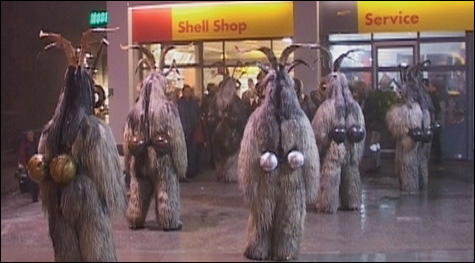
KRANKY KLAUS In this video, Jamie makes you feel you’ve witnessed a violent crime. |
Cameron Jamie’s legend precedes him — like the tale of when he wrestled Michael Jackson. As the story goes, back in the mid ’90s, Jamie often spent his lunch hour outside the Hollywood Wax Museum watching a Michael Jackson impersonator. One day, Jamie asked him, “Hey, you want to wrestle?” And Michael Jackson said, “Sure.”
“Honest to God,” Jamie insists when he tells me about it at MIT’s List Visual Art Center, where the 37-year-old’s first American museum retrospective, organized by Minneapolis’s Walker Art Center, is on view through July 8.

In the resulting 1996 video, The New Life, they face off in Jamie’s Los Angeles apartment. Jamie resembles a scrawny version of Leatherface from The Texas Chainsaw Massacre, wearing longjohns, a rubber novelty butt, and a creepy self-portrait mask that he commissioned from a wrestling-mask maker in Mexico. Punctuated by Jackson’s trademark squeals, their grappling, grunting, and panting has a sexual air. It nails our craving for connection with pop celebrities and the wondrous strangeness of “Wacko Jacko.” Underneath lurk questions of how we forge our identities — Jamie with his masked shenanigans, Jackson with surgery, and the look-alike impersonator with his act. Jamie recalls, “I asked him, ‘So is this like the weirdest thing you’ve ever done?’ He said, ‘No, not at all. I once had to do a striptease for a rich Saudi Arabian oil tycoon.’ ”
Jamie grew up in nowhereville Los Angeles suburbs, shuttling between divorced parents, hanging out in his bedroom playing records, and drawing. For fun he photographed spook houses and suburban front lawns turned into cemeteries for Halloween. He was fascinated with stunts and costumes and creature features, with the odd amateur rituals of America, with reimagining yourself into a more magical life. He plumbs something particularly LA, where divisions between mundane reality and fantasy become muddled because the region’s landscape appears regularly in films and television.
His early-’90s piece Untitled (Eight Portraits) got its start when he had a street artist draw his caricature with a Bart Simpson doll he’d found. He paid one artist after another to copy the image, so that the caricature evolves into a portrait of a mother and child in pastel, then oil, then pancake, then styrofoam, then painted photo. These artworks are godawful, and funny, and they embody a catchy idea: in our awkwardness and mistakes we find the messy root of our humanity.
“Cameron Jamie” surveys his photos, surreal drawings, and melting-face monoprints as well as commissioned masks and paintings. Serving for the most part as relics of actions and ideas, these don’t reward extended viewing. Where Jamie excels is in his documentary films, which are shown here in a continuous loop — set aside two hours to watch them all.
After making the Michael Jackson wrestling video, Jamie heard about local teens staging wrestling matches in their backyards. He began videotaping these contests in 1997; that culminated in his visceral film BB (1998–2000). Teen boys in masks and painted faces wrestle in a makeshift ring surrounded by one-story bungalows, crashing into one another, leaping off ladders and roofs, bashing one another with metal chairs. They ape TV-wrestler moves in an apparent mix of play and real violence. Jamie’s format — gritty black-and-white Super 8 film accompanied by the roar of the sludgy metal band the Melvins — is a perfect match for his subject. He puts his camera in the middle of things and then slows the action a bit, heightening the drama. The more you watch, the more it seems a study of modern American male coming-of-age rituals.
Jamie moved to Paris in 2000, sick of the soullessness of Southern California and seeking a quiet, old place, away from the pack. But he returned for work. Shot in Detroit in 2002, the video Spook House is a montage of overlapping amateur haunted-house skeletons, smoke machines, electric chairs, flying ghouls, and demon clowns. Over its 19 minutes, the blood and gore begins to feel all the same. Jamie favors an artless, authorless style that suggests police-evidence photos. He sees it as a way to draw viewers in. (For me it can grow dull.)
That December, he visited a small Austrian village to document its St. Nicholas feastday traditions. In the video Kranky Klaus, a man playing the saint visits shops and homes giving out chocolates. He’s accompanied by a group of Krampuses, “companions of St. Nicholas,” costumed men that look like evil Wookies with goat horns, chains, and clanging bells. The ritual is astonishing for its mix of cheer and brutality. While St. Nick placidly stands by, the Krampuses wrestle shoppers to the snowy ground. They invade homes and meeting halls, overturning tables, throwing boys to the floor, harassing parents, pulling children’s ears. The Krampuses scatter a group of shell-shocked teens, punching the boys and bringing one girl to tears. “There is no need to be afraid,” a beast growls. “You must behave yourself. It’s okay to be a little bad like me. Stop crying.” You feel you’ve witnessed a violent crime.